Module 5 Wildlife Control Methods
In wildlife damage management (WDM), a variety of methods and tools are used to reduce wildlife conflicts to tolerable levels. Several methods exist because usually no single technique will eliminate all conflicts. This module highlights those methods and tools.
Learning Objectives
- Explain the need and importance of having a variety of techniques for WDM.
- List tools suggested for WDM.
- Describe methods for resolving wildlife conflicts using Integrated Pest Management (IPM) methods.
Introduction
When you consider the diversity of species and problem situations, it becomes apparent that WDM is not a one-size-fits-all activity. Furthermore, many methods can be used in combination with others. In fact, it is advisable to use several techniques whenever practical, particularly to address long-standing damage situations.
WDM Methods
Methods for WDM fall into the broad categories listed below. To take an IPM approach means using non-lethal control techniques when possible and consider what is least damaging to the environment. If the nuisance or damage is below a tolerable threshold, begin with the first four methods.
- Habitat modification
- Exclusion
- Frightening devices
- Repellents
- Toxicants
- Shooting
- Trapping
- Other methods
Habitat Modification
All animals need water, food, and shelter. Eliminate any of these elements and animals cannot survive. Habitat modification addresses all three of these life requisites. An extreme example of habitat modification is to pave a lawn with asphalt to stop mole damage. Although extreme, it would be effective and relatively permanent. Most habitat modifications are more subtle, such as cutting brush around the perimeter of the yard, but they play an important role in long-term WDM. Keep in mind, however, that changes in the habitat to hinder one species may encourage population growth in others.
Typical habitat modifications include:
- modifying bird feeders to reduce the spilled seed from reaching the ground,
- cutting back bushes and trees to reduce cover and access to structures, and
- removing vegetation near a building foundation (Figure 1), and eliminating brush, woodpiles, and junk.

Another example of habitat modification is to mow tall grass to reduce the presence of voles, or to let grass grow to discourage geese. Even small modifications can increase the effectiveness of other techniques. Habitat modification can provide long-term solutions to difficult wildlife conflicts. Unfortunately, some modifications can be expensive, so expect some client resistance. When long-term effects are considered, however, habitat modification may prove cost effective.
Exclusion
Exclusion includes the use of barriers, such as nets, cylinders, and fences, to prevent wildlife from accessing areas and causing damage. This method can provide high levels of protection over the short- and long-term, but exclusion can be very costly when large areas need protection. Exclusion is a popular IPM method and friendly to wildlife. Some experts consider exclusion to be part of habitat modification, but we treat it separately because so many specific tools and techniques for exclusion are available that it warrants a separate module. See Module 6.
Frightening Devices
Frightening devices scare wildlife from a location through non-chemical means. Frightening devices fall into four categories: visual, audio, audio-visual, and biological. Wildlife often quickly habituate to frightening devices, except, perhaps, biological frightening.
Visual
Visual frightening devices include effigies such as plastic owls (Figure 2), scary-eye balloons, and Mylar® tape. Visual devices range dramatically in price, sophistication, and effectiveness.
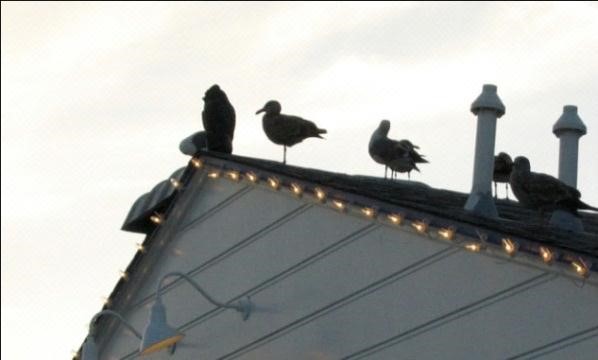
For example, some scarecrows actually move. Animated “human effigies” tend to work much better than the home-made scarecrows, which are better considered as garden decorations.
Stationary visual frightening devices are the least effective, as birds tend to habituate to these devices in a few days. Whenever possible, choose a frightening device that moves, such as a Scary-eye balloon swaying in the wind (Figure 3).

Strobe lights are marketed to frighten wildlife such as squirrels and raccoons. Geese and crows can be dispersed from a night roost by pointing a spotlight, laser pointer, or laser pistol (such as the Avian Dissuader®) at them. As a general rule, green lasers work on diurnal birds and red lasers work on nocturnal species. Always use lasers safely. Do not shine them directly in the eyes of birds or humans. Try to position the laser so its beam shines parallel to the ground.
Audio
Audio or audible devices include propane cannons and distress calls. Propane cannons (Figure 4) produce a noisy boom that is suitable only for rural settings. Distress calls have more versatility and can target a specific species, such as crows. Check local ordinances and consider the effects on the neighbors before using any noisemakers. As for ultrasonic devices, no evidence is available that supports any claim that they are effective in repelling wildlife.

Audio-visual
These use sight and sound to frighten wildlife. Fireworks-based noisemakers, known as “pyrotechnic devices,” will effectively disperse birds over the short-term. Use of pyrotechnics requires training and consideration of safety and legal issues.
Biological
Guard animals such as dogs and llamas sometimes are used to protect livestock, especially sheep, from predators. The livestock and the guard animal must be kept within a fenced area. Dogs can protect orchards, Christmas tree plantations, or vineyards from deer or turkey damage. Dogs within an invisible-fence system may reduce deer damage to home garden and landscape plantings.
Hazing involves the use of dogs, hawks, falcons, or radio-controlled aircraft or boats to drive nuisance animals from a site. Canada geese can be hazed with border collies to remove the birds from golf courses, public parks, or similar locations. Occasionally, hawks are used to chase other birds from airport runways or vineyards.
Birds cannot be hazed in their nesting areas during the nesting season because of the Migratory Bird Treaty Act (MBTA). Do not haze geese during their molt (usually mid-June to mid-July), because they are vulnerable and cannot fly. Secure a permit that allows the taking of geese before beginning hazing activities. Even a well-trained dog might accidentally injure a goose while chasing it. Without a permit, this would be a violation of the MBTA.
Repellents
Repellents are chemicals that deter animal activity through, pain, fear, touch, or aversive conditioning. In most states, you must have a pesticide applicator license to use these products commercially. Homeowners can purchase and use over-the-counter products on their property. The effectiveness of repellents often is highly variable, depending on the motivation of problem animals, alternative resources, weather, skill of the applicator, the animal’s previous experience with the repellent, and the active ingredients in the repellent. Be aware that manufacturers only have to prove a product is safe when used as labeled to sell as a repellent. They do not have to show it works, and many repellents have not been adequately tested.
More information on repellents is in Module 7.
Toxicants
Toxicants are chemical compounds used to kill problem animals such as house mice, Norway rats, pigeons, starlings, and house sparrows (Figure 5). When using toxicants, considerable care must be taken to minimize risks to non-target animals, including wildlife, livestock, pets, and people. The US Environmental Protection Agency (EPA) requires that all applicators must be trained and certified to use restricted use pesticides, covered in Module 7.
Toxicants should be integrated with other WDM methods, such as habitat modification and exclusion, to increase their effectiveness. Always read the label for details and restrictions on the use of a toxicant. For example, most toxicants for rats and mice only can be used “in and around structures” and are not legal for use in landscapes away from buildings.
More information is available in Module 7.
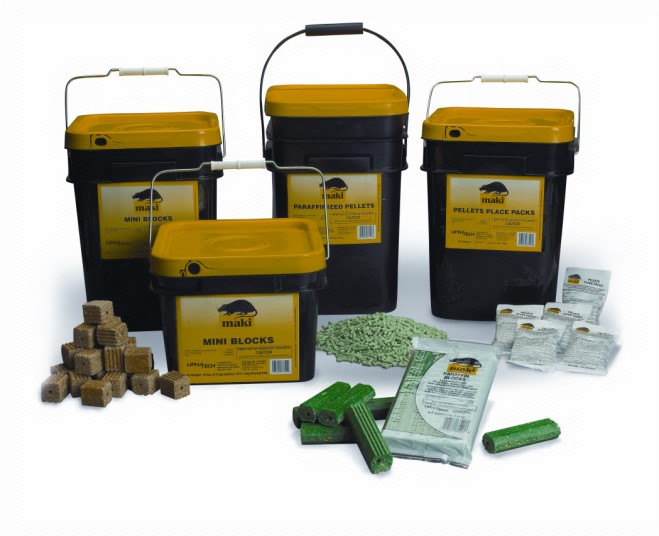
Shooting
Firearms include pistols, shotguns, rifles (Figure 6), and air rifles (high-end pellet guns).

Shooting is appropriate for medium to large mammals (the size of a squirrel and larger), birds, and reptiles. Shooting requires training and skill and is not recommended for homeowners and Master Gardeners. We list it here as it is sometimes the most viable and cost-effective way to deal with a wildlife conflict. Safety concerns and legal restrictions must be considered before shooting. For proper training in the use of firearms, attend a hunter education course or a training course sponsored by the National Rifle Association.
Although shooting may be common in rural areas, many states and communities have laws or ordinances that regulate the discharge of firearms. For example in New York, it is illegal to discharge a bow or firearm within 500 feet of a building without landowner permission. Some communities have completely banned the discharge of firearms. You must know all related state and local laws and regulations before shooting to remove problem wildlife. Contact your local police department, municipal office, or state wildlife agency for specific information.
Trapping
The information on trapping will familiarize you with the various types of traps and their use. Traps are among the most common tools used to manage wildlife damage, so it is important to understand how they work and how to use them. People often misapply the term live trap to refer to cage and box traps, when in fact many other traps also catch animals alive. In this manual we will use the more accurate terms cage traps and box traps (Figure 7) to describe those that imprison animals. In general, we recommend that Master Gardeners and homeowners use cage and box traps for the majority of their trapping.
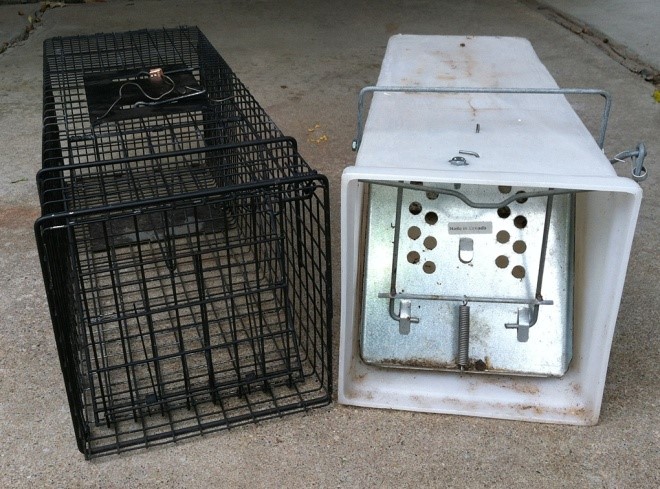
Use of a cage or box trap offers many advantages. For example, you can see what you have caught and then can release non-target animals. Cage and box traps are easy to set and double as carriers. An animal enters a cage or box trap and steps on a treadle, which causes the door(s) at the end(s) of the trap to close. Typically, little site preparation is needed. These traps generally are safe for children and pets. Most people think they are humane, but some animals may hurt themselves due to the stress of being restrained, or while trying to escape.
Disadvantages to cage or box trapping include the time required to check traps frequently and the possibility of capturing unwanted animals. If these traps are used improperly, an animal may die in it from attacks by wildlife, pets, or people; lack of food or water; or exposure to weather extremes. Cage and box traps are not universally effective in capturing animals. Some species, such as coyotes and foxes, may avoid them. Even individuals of species that are easy to catch in cage traps, such as raccoons and gray squirrels, can become “trap-shy,” especially if they have been captured previously.
Proper bait selection and trap location can reduce the risk of capturing non-target animals. For example, raccoons like sweet baits and using them will reduce captures of cats, skunks, opossums, and other animals that are attracted to fish-based baits.
Always have a plan for animal disposition before you start trapping. In some states such as New York, it is illegal to transport live nuisance wildlife off of your property without a permit or license. Regulations may limit the distance some species (e.g., vectors of rabies such as raccoons, skunks, and foxes) can be moved to reduce the spread of disease. Some states limit the movement of any captured wildlife species. Humane euthanasia of wildlife, an alternative to relocation, often is difficult in urban areas without specialized equipment. Training and experience are needed to catch and handle animals humanely.
Additional information is provided in Module 8.
Mouse and rat snap traps
The familiar mouse trap (Figure 8) is a type of body-gripping trap. Your trapping strategy will vary depending on whether you are capturing mice, rats, or other small mammals. If the targets are mice or rats, you will need many traps, so use a model that is easy to set. Many options besides the traditional mouse snap trap are available.
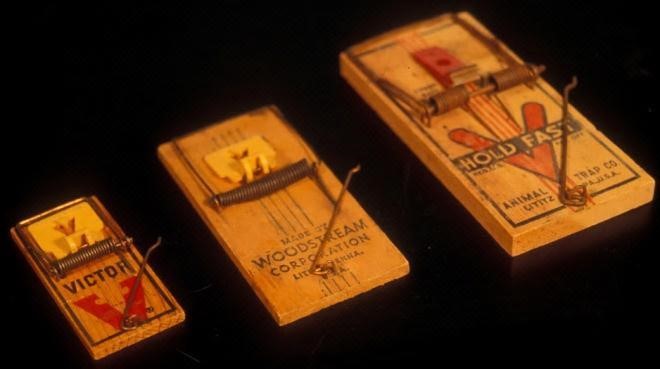
Snap-back traps with expanded triggers and the “clothespin” design (Figure 9) are much easier to set than the traditional mouse trap. The Quick Kill Mouse Trap® made by Victor® has a lid over the bait cup. Only animals that seek the bait will lift the lid, which is what triggers the trap. An animal can accidentally step on the lid without setting off the trap. The bait cup is located to position the mouse in the perfect strike position.
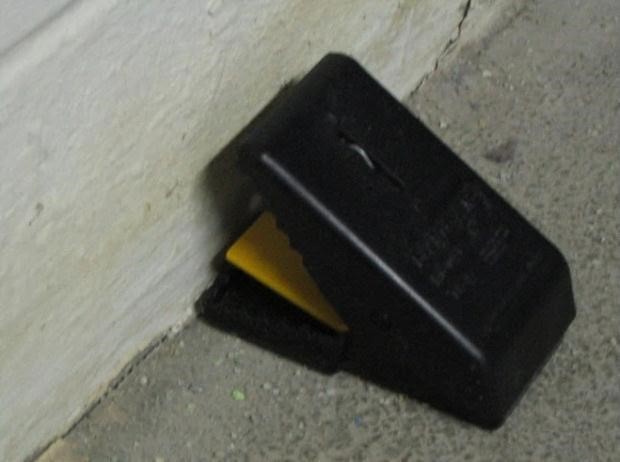
This trap is more selective and more effective than a traditional mouse snap trap. It has a safety catch and will not fire if it is picked up.
Multiple-capture traps
Multiple-capture rodent traps can catch more than one animal without having to be reset. Most are designed for mice. Some brands, such as Ketch-All®, will catch animals up to the size of chipmunks. Some designs (e.g., Ketch-All® and Kwick Katch®) have a wind-up spring that powers a rotating mechanism. Other traps (e.g., Victor Tin Cat®) have one-way doors that allow mice to enter but not leave. As with all live traps, you must check it frequently so that animals are not exposed to extreme temperatures or attack by other animals taking advantage of restrained prey.
Lures and baits
Lures can help bring the target animal to your trap. Lures are concentrated odors and may be detected by wildlife from great distances. They tend to be liquid and fall into three categories: food-based, gland-based, and curiosity.
Food-based lures trigger hunger. They are subdivided into sugary baits called “sweet baits” or oil and protein baits called “meat baits” or “fish baits.”
Gland-based lures trigger sexual or territorial behavior. Urine is a gland-based lure and should be treated as a biohazard. Do not expose your face or hands to urine.
Curiosity lures are odors that likely are unfamiliar to the animal, yet attractive enough to cause the animal to investigate.
Baits typically are food-based materials used to attract animals into traps. They come in chunks, pastes (Figure 10), and powders.
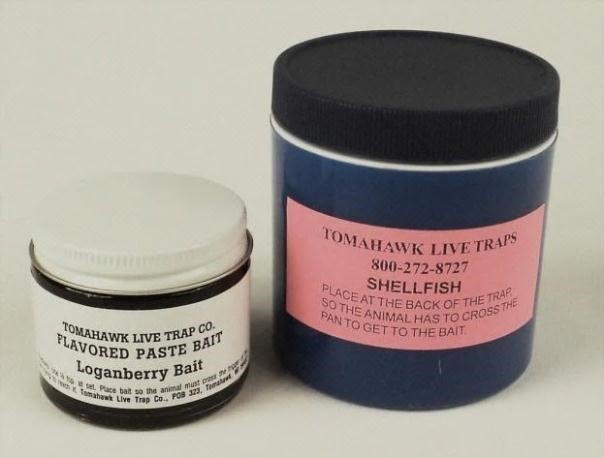
Other Methods
Biological control
Biological control typically involves the introduction of a disease or predator to manage a target population. Control using diseases rarely is employed due to the risk of unexpected consequences. No disease-based products are registered for wildlife control in the US.
Wildlife control with predators, although widely praised by the public, rarely works. For example, some people think that mice and voles can be controlled by placing perch poles around a field to encourage the presence of raptors. However, predators rarely reduce prey populations low enough to meet landowner expectations. Even though house cats may be good “mousers,” they cannot effectively control high populations of rodents, and they may take non-target species such as songbirds and other small mammals.
Fertility control
Fertility control essentially is birth control for wildlife. Most contraceptive methods still are experimental and require permits available only to researchers and veterinarians. However, Innolytics, LLC has an over-the-counter product that, when fed to feral pigeons for a sufficient amount of time, may stop them from laying fertilized eggs. These materials are not available in all states and may require specialized training, permits, or a pesticide applicator’s license for use.
Many wildlife species are long-lived and there are very few examples where long-term use of fertility control agents have actually reduced wildlife abundance and associated damage. Also, in open populations, movement of new animals into the area may offset the lack of reproduction. In some cases, fertility control has stabilized population growth but not reduced animal numbers or their negative impacts.
Questions for Reflection
- Provide some examples of habitat modification and the species for which the technique would be appropriate.
- Explain the four different categories of frightening devices.
- If trapping an animal that is causing damage, how would you decide which of the three categories of lures to use?
- A homeowner has rodents eating grain in the barn and firmly believes that getting two or three cats would take care of the problem. What would you tell the homeowner?
- Explain the advantages and disadvantages of using fertility control for pigeons.